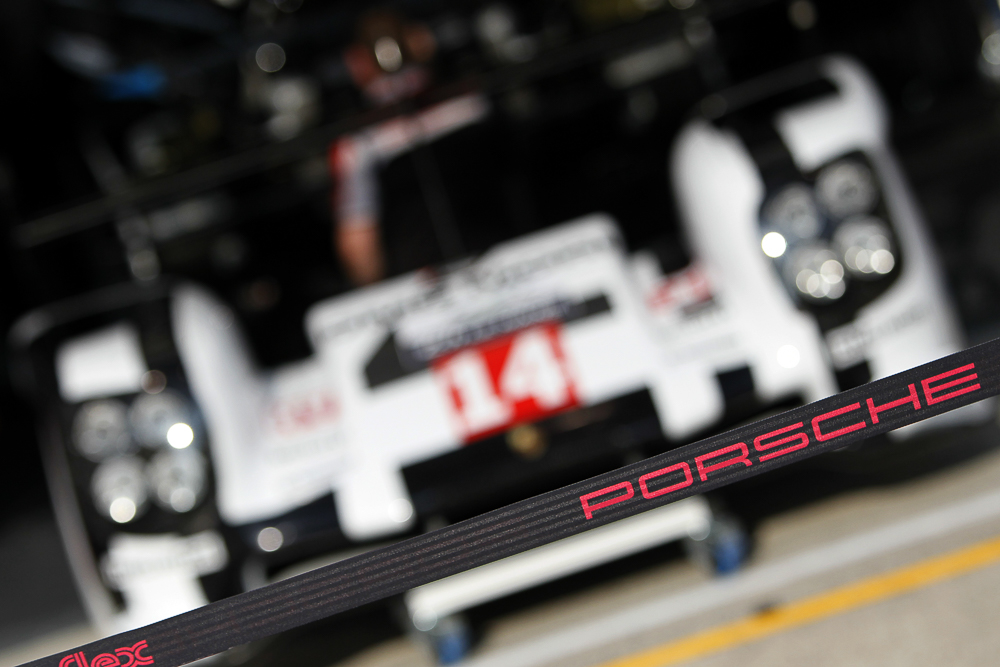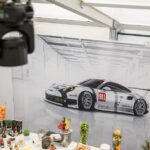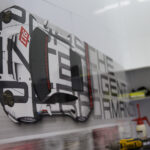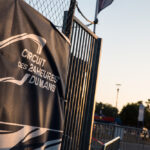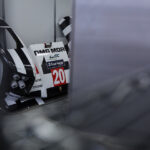Porsche. The Road to Le Mans (2014)
Interviews | crankandpiston | EVO Middle East
James joins Porsche for its historic return to the 24 Hours of Le Mans in 2014, and finds out firsthand what goes into producing a front-running LMP1 outfit from the ground-up.
Originally posted – 25 June, 2014 | crankandpiston.com
Why come back?
It’s a question that, amidst the euphoria of Porsche’s much-celebrated and historic return to the top class of the 24 Hours of Le Mans, seems to have been swept under the rug. With 16 victories, using six different models and encompassing 28 years at La Sarthe, Porsche today boasts the most impressive record of any manufacturer at Le Mans as well as several other records into the bargain: not only have a record 812 different Porsches been entered at Le Mans, the company still holds the fastest average speed ever set during qualifying (251.45kph).
Motorsport can be a cruel battlefield though, and amidst the fairy-tale endings and heart-warming underdog performances lie heart-breaking last lap retirements, career ending accidents, and underwhelming top level returns (step forward Michael Schumacher). Why then was Porsche so keen to put its reputation and its record on the line when it had so much to lose and so little to prove?
“You can only live from your heritage and what you have achieved for a certain amount of time, but not for ever,” explains Head of Porsche Motorsport Hartmut Kristen. “And we felt that we had been away from our second home long enough.”
We’re currently sitting in the Porsche hospitality area at the 2014 24 Hours of Le Mans, and as much as Herr Kristen is invested in our conversation, his eyes begin to dart from my notepad on the table to the bank of flatscreen TVs fixed over my right shoulder. As we talk, he begins flipping his mobile phone over and over with both hands, although never once does he look at the screen. It’s clearly a tense time for anybody wearing a white ‘Porsche’ monogrammed polo shirt. The 12-hour mark has been and gone, and in an event already packed with emotion, both Porsche 919 Hybrid prototypes are in the running for a potential podium.
No matter how much the issue has (understandably) been downplayed by the company, the illusive ‘17th win’ isn’t far from anybody’s minds. Hartmut though is quick to dismiss this.
“Winning here at Le Mans is not just expertise and all that. You always need a certain amount of luck. If you only count experience, then Audi would definitely be the top-runner. If you only consider this year’s results, then Toyota [which, the time of interview, led the 2014 WEC standings] would be favourites. It’s not a simple case of ‘turn up and win’.
“Another thing you have to take into consideration is that regulations have changed since last year’s Le Mans. These new rules work in a way that has more connection with future road cars, and that was another reason why 2014 was the right year for us to return. But we’re not looking for miracles. This year we’re just looking to compete on an equal level. And we know we can do that.”
It’s an emphatic comment, and a valid one. Already the 919 Hybrid, in only its third official race this season, has demonstrated genuine competitive pace. In its race debut at the World Endurance Championship season opener at Silverstone, the new prototype took a podium finish after six hours of racing that saw barely half a second per lap cover all six entrants in LMP1-H. Those vibration issues that beset the team during the 919’s initial roll-out at Weissach last year – an issue that led to a major redesign of the V4 engine at the eleventh hour – have clearly been left behind. More so than its return to top level motorsport after a near two-decade absence though, the 919 Hybrid’s appearance at Silverstone marked a historic moment that many thought would never happen: Porsche and Audi on the road to Le Mans, together as equals. And rivals.
As far back as 1999, with Porsche insisting that it would return to Le Mans after a (then) one-year sabbatical to replace its out-dated GT1-98 GT, sister company Audi took on La Sarthe for the first time with the R8R and the vastly experienced Joest outfit. Together, they finished 3rd. One year later and now with the innovative R8, Audi dominated, taking the top three steps a full 20 laps ahead of its nearest competitor. It was a result that marked the start of a new era, one that has seen Ingolstadt’s cars beaten only twice to victory road since 2000.
Porsche meanwhile, after an abortive attempt with its LMP2000 project and a decision to concentrate attention on American Le Mans Series honours with its LMP2-category RS Spyder from ’05-’10, acknowledged that a return was still on the cards. If, of course, parent group Volkswagen would allow Porsche and Audi to go head-to-head on-track.
“The board decided in 1998 that Porsche would have to set its priorities differently, and so more focus went into strengthening the road car division,” Hartmut continues. “We had to prove that Porsche was capable of developing and producing more than just sports cars for the road. And when you look at what’s happened since then and what has been created, like the Cayenne model range and the Panamera, then we have…oh, and the Carrera GT, which we developed right after stopping our top level motorsport program. And the GT3 R Hybrid. Thanks to all of them, the company is on much more solid ground compared to where we were in the early ‘90s. You have to set your priorities if you want a company to survive profitably.
“But when you look at Audi’s record and ours, together we have created a great history at Le Mans. And the board understood this, understood the importance. As long as the decision makers in the car group feel that this kind of competition is what can bring the group forward, they’re all for it.”
To the surprise of many, and with speculation mounting that Porsche – or indeed Audi – might enter Formula 1 to leave the La Sarthe path clear for its sister brand, the VW Group gave the go ahead for Porsche’s emotional return. Under the proviso, however, that the two brands would not compete against each other directly.
Consequently, whilst Audi would continue to run diesel-powered engines (used to great effect since 2006 when the R10 TDI took the first ever outright victory at Le Mans for a diesel-powered car), Porsche’s new contender would use a 2.0-litre petrol single-turbo direct injection V4.
Two marques, two fuels, two separate target audiences out in the real world. The battle lines had been drawn.
With the go-ahead given, it was time to start the arduous process of building a race team from scratch. A vastly developed infrastructure, thanks largely to the success of both the Cayenne and the Panamera – two family-orientated models that rid Porsche of its ‘niche sportscar’ label – aided in this endeavour, and a 230-strong team (100 of which were engineers) and race headquarters at Weissach were set up in no time.
“We started putting the team together in 2011, but the moment when we said, ‘okay, let’s do this’ was in early 2012, and the pace really picked up after that,” Hartmut continues. “We really didn’t have a lot of time to put everything together, but I think what made it possible was that by that point, we had a small core group already doing pre-development, bouncing ideas around simply because the way we thought about going racing had changed. So, when the decision was made, it really was like flipping a switch. We had to hire people of course, get them together, and define processes, so in that respect it took a lot of work. But I think it has been quite successfully done.”
There’s a roar from downstairs that catches both Hartmut and I off-guard, our eyes immediately swinging to the bank of TV screens. The rain is still sheeting down, the sound ricocheting off the window like hail. On-track, GT after LMP are sluicing wide into run-off areas and into gravel traps, unable to stop, and a massive twitch from one of Porsche’s 911 RSRs has supporters downstairs on their feet.
There’s a brief shot of the main grandstand, now swathed as it is in plastic raincoats and umbrellas. Out of the gloom though raises a Porsche flag, emblem proudly flying. The flags will ultimately not stop flying until well after the race has finished, a testament to the enthusiasm and passion for the returning marque. A sentiment that, once the on-track action has calmed down, reminds Hartmut of the process of raising a team from the ground-up.
First order of business was Porsche’s new prototype contender. In-keeping with new fuel-friendly technical regulations, the 919’s hybrid system combines the 2.0-litre V4 with an energy retrieval system and electric motor package, power from which is transferred across both axles. Whilst 500hp from the V4 powers the rear wheels via a seven-speed racing transmission, energy recovered from the exhaust gases under braking is converted to electricity and stored in the on-board lithium-ion batteries (a principle similar to F1’s KERS system). Up to 185kW/250hp of electrical power can subsequently be sent to the front wheels, and the almost instant torque from this re-generated energy essentially makes the 870kg 919 all-wheel drive at select intervals around the track, improving overall pace and laptimes as a result.
It’s all phenomenally complicated, but such is the importance of every tenth-of-a-second. And with no crossover between the new 919 and Audi’s established R18 e-tron – officially at least – Porsche was on its own. Unsurprisingly, development of the company’s 918 Spyder hybrid proved hugely significant.
“The 918 Spyder was important, specifically for our sportscar customers. When we look at what our sportcar customers want to buy, they may not look at what the fuel prices are: they buy these cars for their entertainment. And when everybody starts talking about reduction of fuel consumption and how to create performance in a car, you get scared. By showing the concept of the 918 Spyder and making it reality, we have created an interesting future where people can say that Porsche understands and can produce entertaining sportcars in the future with very low fuel consumption.
“Consider how the hybrid technology within our company has developed: four years ago at the Geneva Auto Show we presented the 918 Spyder as a show car, the 911 GT Hybrid as a racecar, and the Cayenne hybrid. Now four years later, these have all become reality. We have gone to the next step of hybrid technology, and for the size of our company, that is a huge achievement.”
One need only look at the driver line-up to understand Porsche’s focus on ‘achievements’. Of the six drivers across its LMP1 line-up, two are former outright Le Mans winners (Timo Bernhard and Romain Dumas), three are former category winners (Bernhard, Dumas and Marc Lieb), and combined, the line-up boasts a frankly staggering 37 starts at Le Mans.
Then there’s the elephant in the media room: Mark Webber. With 215 Grand Prix starts and nine victories to his name across 11 years, few could deny his talents behind the wheel. But before this year’s Silverstone 6 Hours, it had been 15 years since Webber’s last start in an endurance race, and his previous Le Mans efforts, though spectacular, were ultimately fruitless. Why then did the likeable Aussie prove such a crucial addition to the line-up?
“He has some experience with Le Mans that goes back as far as our last race here,” Hartmut explains (there goes the mobile again). “He’s also a typical example of how to meld different experience and know-how together. In Formula 1 today, it is motorsport at a very high and sophisticated level, so he is used to the media attention. Plus he already has experience with hybrid technology, so we believe he fits well with our brand and into our team.
“But it’s not just about Mark. All our drivers have to be quick and have to fit with our brand, but they all have different strengths and weaknesses, so at the end of the day you try to form a team that is as strong as possible. In endurance racing you don’t necessarily need the best or the strongest individuals because they’re not fighting against each other. You have to get people who fit well together, and that as a group are stronger than they would be as individuals.”
At this point, a roar from the commentary being pumped through the hospitality area’s speaker system grabs us both. All eyes are now firmly on the TV screens. An LMP2 car is off in the gravel and rain has been rumoured. Hartmut, all too aware that a sudden and ferocious downpour saw both an Audi and Toyota tangle and pile into the Armco earlier in the race, is focused firmly on the race. Our conversation, understandably, is now forgotten.
Ultimately Porsche’s return to Le Mans was not the fairy-tale ending many hoped it would be, despite the #20 car of Mark Webber, Brendon Hartley and Neel Jani spending several hours heading the field. Both 919 Hybrids are eventually struck down with engine issues as the race enters its final stages, and it is instead Audi that produces a storming drive from behind to take its 14th win at the event in 16 years.
There is disappointment of course in the Porsche garage, but at the same time satisfaction. For the 919 Hybrid to run almost three-times longer than it had hitherto managed – and competitively so – in only its third official race start marks an enormous statement of intent for Porsche.
The ‘17th win’ may not have emerged in 2014, but there’s no doubt the Weissach crew will not be satisfied until it does. It’s a result that’s now 16 years in the making, after all. And as we know, a lot can change in that time. Audi may want to remember that.
Images | Eric Fabre and James Gent
Interviews | crankandpiston | EVO Middle East | James Gent




